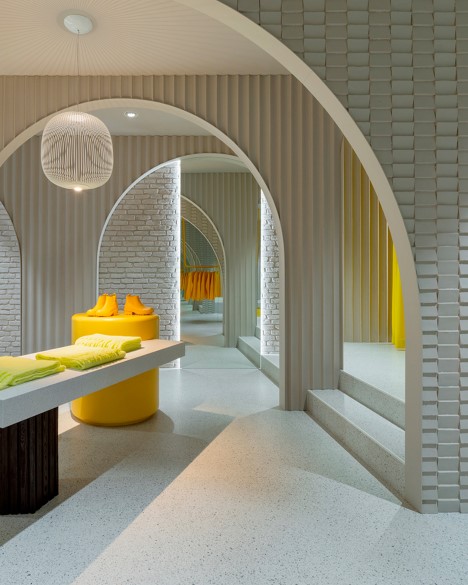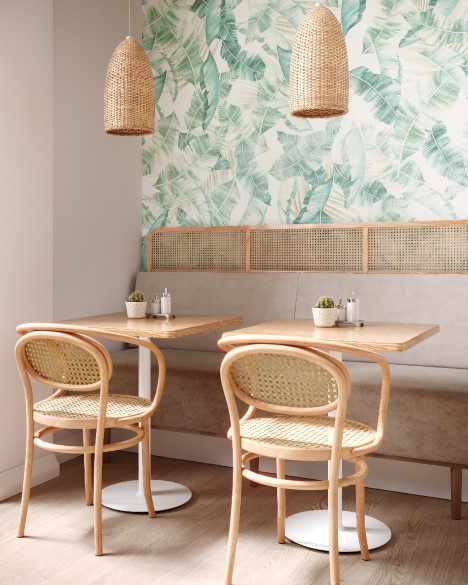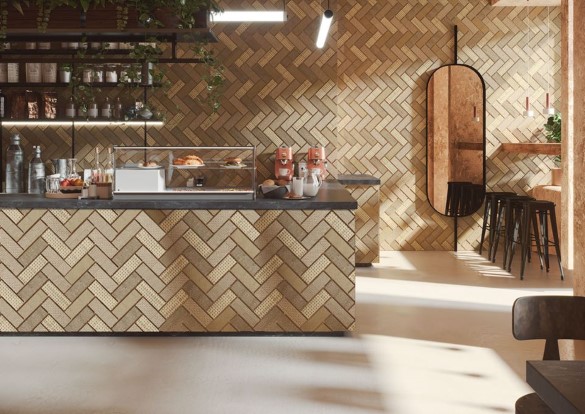It’s clear that in retail spaces, design goes beyond pure aesthetics. A brand’s design concept is the backbone of its identity, key to exceeding customers’ expectations. We’re living through an era in which digitalization and technology are reshaping every facet of our existence, and the world of commerce is no exception.
This fusion of design and technology is redefining our understanding of commercial spaces, setting the scene for market-leading brands.
7 outstanding trends for retail spaces of the future
The world of retail is constantly shifting and evolving, and creativity and innovation are crucial for brands that want to stay at the vanguard.
1. Integrated technology: omnichannel-led strategy
In commerce, technological acceleration is about more than contactless payments and mobile apps. It’s about integrating these elements so fluidly that they enhance the shopping experience – rather than distract from it. And every detail matters. Opting for materials and designs that are as innovative as they are functional can be the difference between a forgettable shop and one that becomes its customers’ preferred destination.
Almost a third of the world’s population is now generation Z, and their buying power is growing. Retailers’ success rests on developing omnichannel experiences and adapting shops to this group’s habits and preferences.

Fitwall- Wave White Sand
2. Flexible spaces, adapted to the future of retail
Adaptability represents a quieter, but no less impactful revolution in interior design in this sector. The commercial space of today is a blank canvas; one that can be adapted to shifting needs or seasons. This is more relevant to some spaces than others. In health and wellness retail for example, spaces might need to be quickly changed around to offer experiences like skincare workshops, or sections dedicated to health and nutrition or dermocosmetics.
The key here is choosing the right solutions for that level of flexibility. Decorative panels are a fine example: Alluslate® and Fitwall® panels offer a durable, aesthetically pleasing solution. Lightweight and easy to install, they can be quickly moved around to switch up the design of the space.
3. Next-level store customisation
The digital age has seen consumer expectations skyrocket in terms of customization. It is no longer enough to offer quality products; customers expect a customized and truly sublime customer experience.
From shops that tweak their lighting and music according to the time of day, to others offering outfit suggestions via augmented reality; customization is redefining retail. Innovative materials such as KRION® are key to this design landscape, giving retailers the potential to add touchscreens to functional and aesthetically pleasing counters.
Want to see more about the potential applications of KRION® in commercial spaces? Take a look.
4. Sensory design to trigger emotions and connections
The shopping environment has transformed into an emotional landscape. Shops at the cutting-edge of retail are using sensory design to offer immersive experiences that take interactions with customers up a notch. Aromas, textures and sound systems aim to create emotional connections with customers, appealing to all five senses.
This is where Fitwall® comes in, with an astonishing capacity to recreate realistic textures and volumes like concrete, textiles or wood, giving stores the potential to introduce tactile design elements.
KRION® comes in a wide spectrum of colours, meaning it can be used to create visual settings that foster a deeper level of connection with consumers’ emotions.

Fitwall – Mattonella White Clay
5. Supergreen: sustainability in retail interior design
Sustainability is more than a retail trend, it’s a necessity. Customers are becoming increasingly aware of its significance, and they expect their brands to do the same.
This reality has spurred a number of brands into action. Nike is one such example; the brand has built basketball courts from 20,000 pairs of trainers in locations including Belgrade. The initiative is the fruit of its Protecting the Planet philosophy, flying the flag for Zero Waste and taking it to the next level.
In interior design, eco-friendly materials like KRION® are ideal for meeting the highest sustainability standards. SCS certified, KRION® is a sustainable alternative that emits zero volatile compounds (compounds with adverse effects on people and the environment).
6. Unique activities and experiences that capture customers

Alluslate Amazonic Light Matt metal-based decorative panel by Krion.
On the quest for deeper connections with customers, shops like North Face in South Korea have offered experiences that transcend the purchase itself. Its premises are home to an incredible climbing wall, for example.
Closer to home, the healthcare retail sector is paying a lot of attention to this same concept. In this area, it manifests in self-care workshops that create a much more dynamic and comprehensive shopping experience.
In this setting, solutions like Alluslate® make it easy to create spaces that can be adapted to diverse activities. For example, one section of the store could be transformed into a beauty workshop area, with decorative panels designed to give it a spa-like look and enrich the customer experience.
7. Spaces that tempt you to stay

Fitwall – Oz Series, Yellow Clay
The retailtainment trend is transforming shops into welcoming destinations; places where customers want to spend time rather than just money. Clear examples of this are the clothing stores offering stylish cafes, libraries with reading spaces and even small cinema spaces.
In settings like these, materials like Fitwall® enhance the experience, recreating unique room schemes from vintage cinemas to classic reading rooms, enticing visitors to spend more time there and enjoy enriching moments.
The future of retail design is defined by the ever-closer integration of technology, sustainability and the customer experience. Brands adopting these trends not only guarantee their market relevance; they raise the bar in terms of consumer expectations of the shopping experience.






